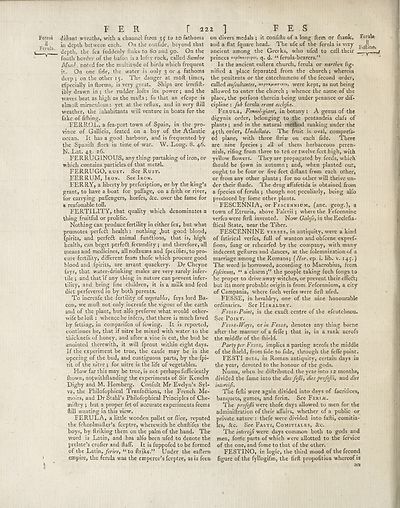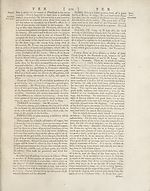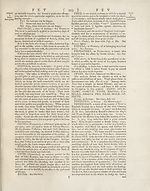Encyclopaedia Britannica > Volume 7, ETM-GOA
(244) Page 222
Download files
Complete book:
Individual page:
Thumbnail gallery: Grid view | List view

Ferrol
Fellh
F E R r 222 1 FES
diftant wreatlis, with a channel from 35 to 20 fathoms on divers medals ; it con fids of a long ftem or fnank, Ferula
in depth between each. On the outfide, beyond that and a flat fguare head. The ufe of the ferula is very ^
depth, the fea fuddenly finks to 80 and 90. On the ancient among the Greeks, who ufed to cdl their (—L
fouth border of the bafon is a lofty rock, called Sumboe princes q. d. “ ferula-bearers.”
Muni’, noted for the multitude of birds which frequent In the ancient, eaftern church, ferula or narthex fig-
it. On one fide, the water is only 3 or 4 fathoms nified a place feparated from the church; wherein
deep ; on the other 15. The danger at moft times, the penitents or the catechumens of the fecond order,
efpecially in dorms, is very great. Ships are irrefift- called aufcultantes, axpoi/tanxix, were kept, as not being
ibly drawn in ; the rudder lofts its power ; and the allowed to enter the church ; whence the name of the
waves beat as high as the mafts ; fo that an efcape is place, the perfons therein being under penance or dif-
almoft miraculous: yet at the reflux, and in very ftill cipline : fub ferula erant ecclefia.
weather, the inhabitants will venture in boats for the Ferula, Fennel-giant, in botany ; A genus of the
fake of fifiling. digynia order, belonging to the pentandria clafs of
FERROL, a fea-port town of Spain, in the pro- plants; and in the natural method ranking under the
vince of Gallicia, feated on a bay of the Atlantic 45th order, Umbellate. The fruit is oval, comprefs-
ocean. It has a good harbour, and is frequented by ed plane, with three ftriae on each fide. There
the Spanifh fleet in time of war. W. Long. 8. 46. are nine fpecies ; all of them herbaceous peren-
N* Lat. 43. 26. nials, riling from three to ten or twelve feet high, with
FERRUGINOUS, any thing partaking of iron, or yellow flowers. They are propagated by feeds, which
which contains particles of that metal. fliould be fown in autumn; and, when planted out,
FERRUGO, rust. See Rust. ought to be four or five feet diftant from each other,
FERRUM, Iron. See Iron. or from any other plants ; for no other will thrive un-
FERRY, a liberty by prefcription, or by the king’s der their ftiade. 1’he drug aflafetida is obtained from
grant, to have a boat for paffage, on a frith or river, a fpecies of ferula ; though not peculiarly, being alfo
for carrying paffengers, horfes, &c. over the fame for produced by fome other plants.
a reafonable toll. FESCENNIA, or Fescennium, (anc. geog.), a
FERTILITY, that quality which denominates a town of Etruria, above Falerii ; where the Fefcennine
thing fruitful or prolific. verfes were firft invented. Now Galefe, in the Ecclefia-
Nothing can produce fertility in either fex, but what ftical State, near the Tiber,
promotes perfect health: nothing ,but good blood, FESCENNINE verses, in antiquity, were a kind
fpirits, and perfect animal funftions, that is, high of fatirical verfes, full of wanton and obfcene expref-
health, can beget perfect fecundity ; and therefore, all fions, fung or rehearfed by the company, with many
means and medicines, all noftrums and fpecifies, to pro- indecent geftures and dances, at the folemnization of a
cure fertility, different from thofe which procure good marriage among the Romans; (Hor. ep. i. lib. v. 145.)
blood and fpirits, are arrant quackery. Dr Cheyne The word is borrowed, according to Macrobius, from
fays, that water-drinking males are very rarely infer- fafcinum, “ a charm;” the people taking fuch fongs to
tile ; and that if any thing in nature can prevent infer- be proper to drive away witches, or prevent their effefit;
tility, and bring fine children, it is a milk and feed but its more probable origin is from Fefcennium, a city
diet perfevered in by both parents. of Campania, where fuch verfes were firft ufed.
To increafe the fertility of vegetables, fays lord Ba- FESSE, in heraldry, one of the nine honourable
con, we muft not only increafe the vigour of the earth ordinaries. See Heraldry.
and of the plant, but alfo preferve what would other- FF.ssE-Point, is the exadt centre of the efcutcheon.
wife be loft.: whence he infers, that there is muchfaved See Point.
by fetting, in comparifon of fowing. It is reported, Fesse-JFays, or in Fesse, denotes any thing borne
continues he, that if nitre be mixed with water to the after the manner of a feffe ; that is, in a rank acrofs
thicknefs of honey, and after a vine is cut, the bud be the middle of the (hidd.
anointed therewith, it will fprout within eight days. Party per Fesse, implies a parting acrofs the middle
If the experiment be true, the caufe may be in the of the (hield, from fide to fide, through the feffe point,
opening of the bud, and contiguous parts, by the fpi- FESTI dies, in Roman antiquity, certain days in
tit of the nitre ; for nitre is the life of vegetables. the year, devoted to the honour of the gods.
How far this may be true, is not perhaps fufficiently Numa, when he diftributed the year into 12 months,
fliown, nofwithftanding the experiments of Sir Kenelm divided the fame into the dies fejli, dies profejli, and dies
Digby and M. Homberg. Confult Mr Evelyn’s Syl- intercifi.
va, the Philofophical Tranfaftions, the French Me- The fefti were again divided into days of facritices,
moirs, and Dr Stahl’s Philofophical Principles of Che- banquets, games, and feriae. See Feri.®.
miftry ; but a proper fet of accurate experiments feems The profejli were thofe days allowed to men for the
ftill wanting in this view. adminiftration of their affairs, whether of a public or
FERULA, a little wooden pallet or flice, reputed private nature : thefe were divided into fafti, comitia-
the fchoplmafter’s feeptre, wherewith he chaftifes the les, &c. See Fasti, Comitiales, &c.
boys, by ftriking them on the palm of the hand. The The intercifi were days common both to gods and
word is Latin, and has alfo been ufed to denote the men, fome parts of which were allotted to the fervice
prelate’s crofier and ftaff. It is fuppofed to be formed of the one, and fome to that of the other,
of the Latin,jOr/Vv, “ to ftrike.” Under the eaftern FESTINO, in logic, the third mood of the fecond
empire, the ferula was the emperor’s feeptre, as is feen figure of the fyllogifm, the firft propofition whereof is
Fellh
F E R r 222 1 FES
diftant wreatlis, with a channel from 35 to 20 fathoms on divers medals ; it con fids of a long ftem or fnank, Ferula
in depth between each. On the outfide, beyond that and a flat fguare head. The ufe of the ferula is very ^
depth, the fea fuddenly finks to 80 and 90. On the ancient among the Greeks, who ufed to cdl their (—L
fouth border of the bafon is a lofty rock, called Sumboe princes q. d. “ ferula-bearers.”
Muni’, noted for the multitude of birds which frequent In the ancient, eaftern church, ferula or narthex fig-
it. On one fide, the water is only 3 or 4 fathoms nified a place feparated from the church; wherein
deep ; on the other 15. The danger at moft times, the penitents or the catechumens of the fecond order,
efpecially in dorms, is very great. Ships are irrefift- called aufcultantes, axpoi/tanxix, were kept, as not being
ibly drawn in ; the rudder lofts its power ; and the allowed to enter the church ; whence the name of the
waves beat as high as the mafts ; fo that an efcape is place, the perfons therein being under penance or dif-
almoft miraculous: yet at the reflux, and in very ftill cipline : fub ferula erant ecclefia.
weather, the inhabitants will venture in boats for the Ferula, Fennel-giant, in botany ; A genus of the
fake of fifiling. digynia order, belonging to the pentandria clafs of
FERROL, a fea-port town of Spain, in the pro- plants; and in the natural method ranking under the
vince of Gallicia, feated on a bay of the Atlantic 45th order, Umbellate. The fruit is oval, comprefs-
ocean. It has a good harbour, and is frequented by ed plane, with three ftriae on each fide. There
the Spanifh fleet in time of war. W. Long. 8. 46. are nine fpecies ; all of them herbaceous peren-
N* Lat. 43. 26. nials, riling from three to ten or twelve feet high, with
FERRUGINOUS, any thing partaking of iron, or yellow flowers. They are propagated by feeds, which
which contains particles of that metal. fliould be fown in autumn; and, when planted out,
FERRUGO, rust. See Rust. ought to be four or five feet diftant from each other,
FERRUM, Iron. See Iron. or from any other plants ; for no other will thrive un-
FERRY, a liberty by prefcription, or by the king’s der their ftiade. 1’he drug aflafetida is obtained from
grant, to have a boat for paffage, on a frith or river, a fpecies of ferula ; though not peculiarly, being alfo
for carrying paffengers, horfes, &c. over the fame for produced by fome other plants.
a reafonable toll. FESCENNIA, or Fescennium, (anc. geog.), a
FERTILITY, that quality which denominates a town of Etruria, above Falerii ; where the Fefcennine
thing fruitful or prolific. verfes were firft invented. Now Galefe, in the Ecclefia-
Nothing can produce fertility in either fex, but what ftical State, near the Tiber,
promotes perfect health: nothing ,but good blood, FESCENNINE verses, in antiquity, were a kind
fpirits, and perfect animal funftions, that is, high of fatirical verfes, full of wanton and obfcene expref-
health, can beget perfect fecundity ; and therefore, all fions, fung or rehearfed by the company, with many
means and medicines, all noftrums and fpecifies, to pro- indecent geftures and dances, at the folemnization of a
cure fertility, different from thofe which procure good marriage among the Romans; (Hor. ep. i. lib. v. 145.)
blood and fpirits, are arrant quackery. Dr Cheyne The word is borrowed, according to Macrobius, from
fays, that water-drinking males are very rarely infer- fafcinum, “ a charm;” the people taking fuch fongs to
tile ; and that if any thing in nature can prevent infer- be proper to drive away witches, or prevent their effefit;
tility, and bring fine children, it is a milk and feed but its more probable origin is from Fefcennium, a city
diet perfevered in by both parents. of Campania, where fuch verfes were firft ufed.
To increafe the fertility of vegetables, fays lord Ba- FESSE, in heraldry, one of the nine honourable
con, we muft not only increafe the vigour of the earth ordinaries. See Heraldry.
and of the plant, but alfo preferve what would other- FF.ssE-Point, is the exadt centre of the efcutcheon.
wife be loft.: whence he infers, that there is muchfaved See Point.
by fetting, in comparifon of fowing. It is reported, Fesse-JFays, or in Fesse, denotes any thing borne
continues he, that if nitre be mixed with water to the after the manner of a feffe ; that is, in a rank acrofs
thicknefs of honey, and after a vine is cut, the bud be the middle of the (hidd.
anointed therewith, it will fprout within eight days. Party per Fesse, implies a parting acrofs the middle
If the experiment be true, the caufe may be in the of the (hield, from fide to fide, through the feffe point,
opening of the bud, and contiguous parts, by the fpi- FESTI dies, in Roman antiquity, certain days in
tit of the nitre ; for nitre is the life of vegetables. the year, devoted to the honour of the gods.
How far this may be true, is not perhaps fufficiently Numa, when he diftributed the year into 12 months,
fliown, nofwithftanding the experiments of Sir Kenelm divided the fame into the dies fejli, dies profejli, and dies
Digby and M. Homberg. Confult Mr Evelyn’s Syl- intercifi.
va, the Philofophical Tranfaftions, the French Me- The fefti were again divided into days of facritices,
moirs, and Dr Stahl’s Philofophical Principles of Che- banquets, games, and feriae. See Feri.®.
miftry ; but a proper fet of accurate experiments feems The profejli were thofe days allowed to men for the
ftill wanting in this view. adminiftration of their affairs, whether of a public or
FERULA, a little wooden pallet or flice, reputed private nature : thefe were divided into fafti, comitia-
the fchoplmafter’s feeptre, wherewith he chaftifes the les, &c. See Fasti, Comitiales, &c.
boys, by ftriking them on the palm of the hand. The The intercifi were days common both to gods and
word is Latin, and has alfo been ufed to denote the men, fome parts of which were allotted to the fervice
prelate’s crofier and ftaff. It is fuppofed to be formed of the one, and fome to that of the other,
of the Latin,jOr/Vv, “ to ftrike.” Under the eaftern FESTINO, in logic, the third mood of the fecond
empire, the ferula was the emperor’s feeptre, as is feen figure of the fyllogifm, the firft propofition whereof is
Set display mode to:
![]() Universal Viewer |
Universal Viewer | ![]() Mirador |
Large image | Transcription
Mirador |
Large image | Transcription
Images and transcriptions on this page, including medium image downloads, may be used under the Creative Commons Attribution 4.0 International Licence unless otherwise stated. ![]()
| Encyclopaedia Britannica > Encyclopaedia Britannica > Volume 7, ETM-GOA > (244) Page 222 |
|---|
| Permanent URL | https://digital.nls.uk/189124401 |
|---|
| Attribution and copyright: |
|
|---|
| Description | Ten editions of 'Encyclopaedia Britannica', issued from 1768-1903, in 231 volumes. Originally issued in 100 weekly parts (3 volumes) between 1768 and 1771 by publishers: Colin Macfarquhar and Andrew Bell (Edinburgh); editor: William Smellie: engraver: Andrew Bell. Expanded editions in the 19th century featured more volumes and contributions from leading experts in their fields. Managed and published in Edinburgh up to the 9th edition (25 volumes, from 1875-1889); the 10th edition (1902-1903) re-issued the 9th edition, with 11 supplementary volumes. |
|---|---|
| Additional NLS resources: |
|

